|
|
| Übersicht – Contents: | |
Diese Seite ist Teil des Projektes
|
|
| Übersicht – Contents: | |
Flagge – Flag: |
|
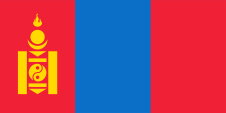 |
Nationalflagge – national flag, |
historische Flaggen – historical Flags: |
|
|
Varianten des 14. bis 17. Jahrhunderts – Variants of the 14th to 17th centuries: Quelle/Source, nach/by: Flags of the World |
|
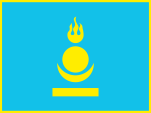  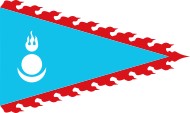 |
|
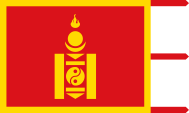 |
1911–1924, |
 |
1911–1924, |
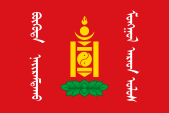 |
1924–1940, |
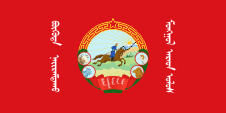 |
1940–1945, |
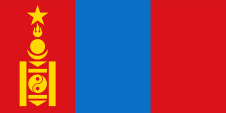 |
1945–1992, |
andere Flaggen – other Flags: |
|
|
unbestätigte Varianten ohne Zuordnung – unconfirmed variants without assignment: Quelle/Source, nach/by: Flags of the World, Flaggenbuch 1939 |
|
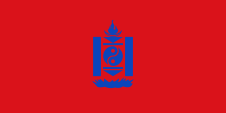 |
1924–1940, |
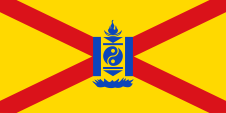 |
1924–1940, |
| Die Flagge der Mongolei zeigt drei senkrechte Streifen in Rot, Blau und Rot, sowie in dem roten Streifen am Liek ein gelbes Emblem. Rot symbolisiert den Sozialismus, Hellblau den Himmel. Blau ist auch die Farbe der mongolischen Rasse. Das Emblem ist das alte mongolische Soyombo-Symbol, das bis 1992 vom gelben Stern des Kommunismus gekrönt wurde. Die Flagge wurde in ihrer heutigen Form am 10.06.1945 angenommen und am 12.02.1992 nach Wegfall des gelben Sterns offiziell bestätigt. Die Farben der Flagge sind seit Juli 2011 per Gesetz niedergelegt. Sie werden folgendermaßen angegeben: Blau = Pantone 300, Gelb = Medium Yellow = ca. Pantone 109, Rot = Pantone 032. |
The flag of Mongolia shows three vertical stripes in red, blue and red, as
soon as in the red stripe at the leech a yellow emblem. Red symbolizes the
socialism, pale blue the heaven. Blue is the colour of the Mongolian race
too. The emblem is the ancient Mongolian Soyombo-Symbol which crowned until
1992 from the yellow star of the communism. The flag was adoped in its
today’s type on 10th of June in 1945 and confirmed officially on 12th of
February in 1992 after the delete of the yellow star. The colours of the flag are laid down since July 2011. They are given as follows: Blue = Pantone 300, Medium Yellow = ca. Pantone 109, Red = Pantone 032. |
| Das moderne Soyombo-Symbol ist ein mongolisches Symbol buddhistischer Weltsicht dar und soll im 17. Jahrhundert von Dschanbadschor geschaffen worden sein, einer angeblichen Reinkarnation des Buddha. Es zeigt an der Spitze ein Feuer mit drei Flammen (Vergangenheit, Gegenwart, Zukunft), darunter die Sonne (Mutter der Mongolen) und den Mond (Vater der Mongolen). Im unteren Teil stehen zwischen zwei senkrechten Balken (Symbol für Stärke) zwei Dreiecke (Speerspitzen), zwei waagerechte Balken (Symbole für das flache Land) und das Ying-Yang-Symbol. Dieses steht für eine dualistische Weltanschauung. |
The mordern Soyombo-Symbol is a Mongol symbol of Buddhist worldview and should have
been created in the 17th century by Dshanbadshor an ostensible reincarnation
of Buddha.
It shows at the top a fire with three flames (past, present, future),
beneath the sun (Mother of the Mongols) and the moon (father of the
Mongols). In the underneath part stand between two vertical bars (symbol for strength) two triangles (spearheads), two horizontal bars (symbols for the flat country) and the Ying-Yang-Symbol. Those stands for a dualistic worldview. |
| Die Mongolen waren früher nahe zu alle Nomaden. Auch wenn sie sich ein riesiges Reich eroberten, hatten sie einen andere Vorstellung vom Staat. Der Großkhan war der oberste Heerführer und das Heer ständig in Bewegung. So gab es kaum feste Residenzen. Der Staat war dort wo das Heer war. Insofern galt es nicht mit Flaggen ein Territorium abzustecken, sondern höchstens die Anwesenheit des Großkhans anzuzeigen, oder das Heer mit Standarten als Feldzeichen auszustatten. Diese waren sehr unterschiedlich gestaltet, aber meist blau, waren oft dreieckig mit rotem Rand oder hatten drei schmale rote Verlängerungen. In der Mitte fanden sich Abbildungen von Vögeln oder Pferden und auch schon das Soyombo-Symbol, nur aus Mond, Sonne und Feuer bestehend. Nachdem die Mongolei im 17. Jahrhundert von China abhängig geworden ist, konnte sich das Land im Zuge der Chinesischen Revolution von 1911 wieder von China unabhängig machen, indem das religiöse Oberhaupt des Lamaistischen Buddhismus, Ngawang Lobsang, zum Bogd Khan ernannt worden war. 1918 marschierten chinesische Truppen ein, das Land wurde 1919 wieder an China angeschlossen. 1920 marschierten russische Truppen unter Baron Ungern-Sternberg ein, auf die 1921 sowjetrussische Truppen folgten und die Machtergreifung durch die Kommunisten ermöglichten. Von jetzt an waren die Flaggen der Mongolei von kommunistischer Symbolik beeinflusst. |
The Mongols used to be almost all nomads. Even if they conquered a huge
empire, they had a different idea of the state. The Great Khan was the
supreme general and the army was constantly on the move. So there were hardly any permanent residences. The state was where the army was. In this way, it was not a matter of marking off a territory with flags, but at most indicating the presence of the Great Khan, or equipping the army with standards as field symbols. These varied greatly in design, but were mostly blue, often triangular with a red border, or had three narrow red extensions. In the middle there were images of birds or horses and also the Soyombo symbol, consisting only of moon, sun and fire. After becoming dependent on China in the 17th century, Mongolia regained its independence from China during the 1911 Chinese Revolution, when the religious leader of Lamaist Buddhism, Ngawang Lobsang, was appointed Bogd Khan. Chinese troops invaded in 1918 and the country was reconnected to China in 1919. In 1920, Russian troops under Baron Ungern-Sternberg invaded, followed in 1921 by Soviet Russian troops, enabling the communists to seize power. Henceforth, the flags of Mongolia were influenced by communist symbolism. |
| Quelle/Source: Die Welt der Flaggen, Flaggen Wappen Hymnen, Flaggen und Wappen der Welt, Volker Preuß | |
Wappen – Coat of Arms: |
|
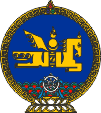 |
seit/since 1992, Wappen der Republik Mongolei – coat of arms of the Republic of Mongolia Quelle/Source: Sodacan, Public domain, via Wikimedia Commons |
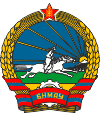 |
1945–1992, Wappen der Volksrepublik Mongolei – coat of arms of the People's Republic of Mongolia Quelle/Source: Corel Draw 4 |
| Das heutige Wappen der Mongolei ist rund und zeigt auf einer dunkelblauen, goldumrandeten Scheibe ein stilisiertes, goldenes geflügeltes Pferd kombiniert mit dem Soyombo-Symbol. Ganz oben drei Edelsteine (Vergangenheit, Gegenwart, Zukunft) und im unteren Teil ein Rad (buddhistisches Symbol) mit einem blauen Seidentuch vor dem Hintergrund vieler aufgehender Sonnen. Am Fuß des Schildes ein Podest aus goldenen Lotosblüten. | The
today’s coat of arms of Mongolia is round and sows on a dark blue golden
bordered disk a stylizeed golden winged horse combined with the
Soyombo-Symbol. In the top three gems (past, presence, future) and in the lower part a wheel (Buddhistic symbol) with a blue silk shawl in front of the background of many rising suns. Below the shield a pedestal from golden lotus blossoms. |
| Das bis 1992 gültige Wappen der Volksrepublik wurde 1960 eingeführt. Es war rund und zeigte einen Werktätigen auf einem Pferd, der vor einer mongolischen Landschaft der Sonne (der leuchtenden Zukunft des Kommunismus) entgegenreitet. Ganz oben der rote, goldumrandete fünfzackige Stern des Kommunismus mit einem goldenen Soyombo in der Mitte. Im unteren Teil ein Zahnrad als Sinnbild der erhofften Industrialisierung. Das Ganze war umgeben von einem Kranz aus Getreideähren, die durch ein Band in den Landesfarben zusammengehalten werden. Das Band zeigte fünf goldene kyrillische Buchstaben (Die kyrillische Schrift war in der Mongolei zwischen 1946 und 1991 gültig. Heute verwendet man wieder das uigurische Alphabet). Die Buchstaben waren: "BNMAU", die Initialen des damaligen Landesnamens: "Bügd Nairamdach Mongol Ard Uls" → "Volksrepublik Mongolei". | The until
1992 used coat of arms of the people’s republic was introduced in 1960. It
was round and showed a worker on a horse which rides in front of a Mongolian
scenery towards the sun (the shining future of communism). In the top the red golden surrounded five-pointed star of the communism with a golden Soyombo in the middle. In the lower part a sprocket as allegory of the expected industrialization. All this was surrounded by a garland off grain ears which are bonded by a ribbon in the colours of the country. The ribbon carryed vive golden Cyrillic letters (The Cyrillic writing was valid in Mongolia between 1946 and 1991. Nowadays they use again the Uigurian alphabet). The letters were: "BNMAU", the initial letters of the then name of the country: "Buegd Nairamdach Mongol Ard Uls" → "People’s Republic of Mongolei". |
| Quelle/Source: Die Welt der Flaggen, Flaggen Wappen Hymnen, Flaggen und Wappen der Welt, Wikipedia (D) | |
Flugzeugkokarde – aircraft roundel: |
|
 |
seit/since 1992, Flugzeugkokarde – aircraft roundel, Quelle/Source, nach/by: Wikipedia (EN) |
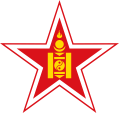 |
1925(?)–1992, Flugzeugkokarde – aircraft roundel, Quelle/Source, nach/by: Wikipedia (EN) |
|
|
|
Landkarte – Map: |
Lage – Position: |
Landkarte des Landes – Map of the Country: |
| Zahlen und Fakten – Numbers and Facts: | |
|
|
|
|
|
|
|
|
|
|
|
|
|
|
|
|
|
|
| 13. Jhd.
· Dschingis Khan einigt die mongolischen Nomadenstämme und unterwirft
Nordasien und Osteuropa 1241 · Zerfall des Mongolenreiches 1271 · Kublai Khan erobert China und gründet die mongolische Yüan-Dynastie 1368 · die Yüan-Dynastie wird aus China vertreiben, China wird von der Mongolei unabhängig, Teilung der Mongolei in Innere und Äußere Mongolei, die Innere Mongolei verbleibt bei China 1369 · Timur unterwirft Mittelasien, Vorderasien, Persien und teilweise Kleinasien 1691 · die Äußere Mongolei wird ein Vasallenstaat Chinas 1911 · Revolution in China, die Äußere Mongolei erklärt sich für unabhängig, Staatsoberhaupt wird Bogd Khan (Oberhaupt der Lamaistischen Religion in der Mongolei) 1918 · Einmarsch chinesischer Truppen 1919 · die Äußere Mongolei wird China angeschlossen 1920 · Einmarsch russischer Truppen unter Baron Ungern-Sternberg 1921 · Einmarsch sowjetrussischer Truppen 11.07.1921 · Machtergreifung durch die Kommunisten, Bündnis mit Sowjet-Russland 1924 · Umbenennung in Mongolische Volksrepublik, neue Verfassung 1940 · neue Verfassung 1946 · China erkennt die Unabhängigkeit der Mongolei an 1960 · neue Verfassung 1963 · Grenzvertrag zwischen China und Mongolei 1989 · Demokratisierung, Abzug der sowjetischen Truppen 1992 · neue Verfassung |
| 13th cent.
· Dschingis Khan unifys the Mongol nomad tribes and submits Northern Asia
and Eastern Europe 1241 · decay of the Mongol Empire 1271 · Kublai Khan conquers China and establishes the Mongol Yuan-Dynasty 1368 · the Yuan-Dynasty becomes banished out of China, China gets independent from Mongolia, partition of Mongolia in Interior Mongolia and Outer Mongolia, the Inner Mongolia remains at China 1369 · Timur submits Middle Asia, Mideast Asia, Persia and partially Little Asia (Anatolia) 1691 · the Outer Mongolia becomes a vassal state of Chinas 1911 · revolution in China, the Outer Mongolia declares itself for independet, chief of state becomes Bogd Khan (Chief of the Lamaistic religion in Mongolia) 1918 · invasion of Chinese troops 1919 · the Outer Mongolia becomes annexed by China 1920 · invasion of Russian troops under Baron Ungern-Sternberg 1921 · invasion of Soviet-Russian troops 11th of July 1921 · seizure of power by the communists, alliance with Soviet-Russia 1924 · rename in Mongolian People’s Republic, new constitution 1940 · new constitution 1946 · China recognizes the independence of Mongolia 1960 · new constitution 1963 · border convention between China and Mongolia 1989 · democratization, withdrawal of the Soviet troops 1992 · new constitution |
| Quelle/Source: Atlas zur Geschichte, World Statesmen, Wikipedia (D) |
| Der Name "Mongolei" lässt sich mit "Land der Tapferen" übersetzen, da das mongolische Wort "mong" "mutig" bedeutet. | The name "Mongolia" is to translate as "Land of the Brave" because the Mongol word "mong" means "courageous". |
| Quelle/Source: Handbuch der geographischen Namen | |